What is Edge Computing
Edge computing refers to the exercise of processing information in the direction of its delivery at the edge of a network, in the region of counting on a centralized cloud or data center. In edge computing, statistics are processed and analysed locally on devices or in nearby servers, lowering latency and permitting quicker reaction times. This technique is especially useful in situations in which actual-time or near-real-time processing is crucial, which include the Internet of Things (IoT), autonomous automobiles, and commercial automation.
Edge computing enhances performance, security, and the capability to manipulate and study information at or close to the beginning, making it a treasured addition to the broader cloud computing atmosphere.
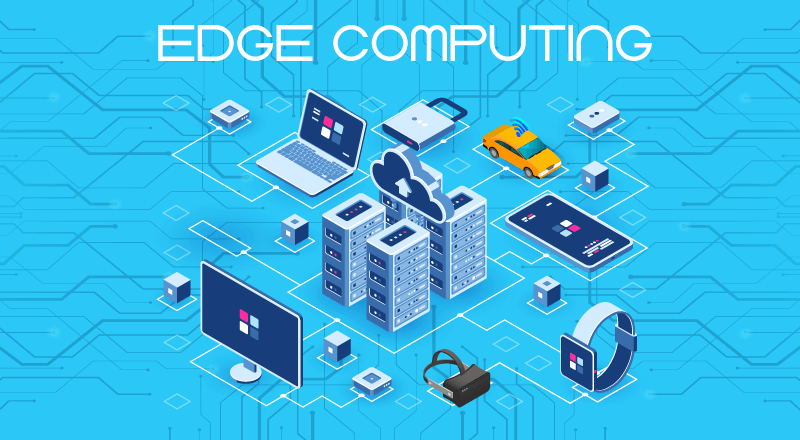
Edge Computing is a buzzword such as cloud, IoT, and Artificial Intelligence. Simply saying, Edge Computing brings the decentralization of networks. Edge Computing is the upcoming enhancement and advancement in technology. The literal meaning of the word 'Edge' is the geographic location on the planet to deliver services in a distributed manner. Edge Computing is a distributed computing system that allows to bring computation of data and storage too close to the source (where data is required). It brings computing as much close as possible so as to minimize the bandwidth, improve response time, and use of latency. Instead of locating the data at a centralized place, the concept of edge computing believes in distributing the computing process of the data. However, cloud computing and IoT are faster plus efficient, but edge computing is a more faster computing method. The objective of Edge Computing is to improve the network technology by moving the computation of data close to the edge of the network and away from the data centers. Such a process exploits network gateways or smart objects for performing tasks and provide services on behalf of the cloud. As it is well-known that per day data is produced in a huge amount that makes its computation difficult and complicated to be handled by the data centers. Also, the network bandwidth limit almost gets exhausted, and response time increase highly. So, when moving computation and data services in the hands of edge computing, it is possible to provide efficient service delivery, better data storage, and IoT management that could minimize the response time and transfer rate of data. With the 5G data network, it has enabled to converge 5G data network and edge technologies within reach. Thus, Edge Computing reduces the long-distance processing and slow communication of the data.
Challenges in Edge Computing
There are the following issues and challenges that take place in Edge Computing:
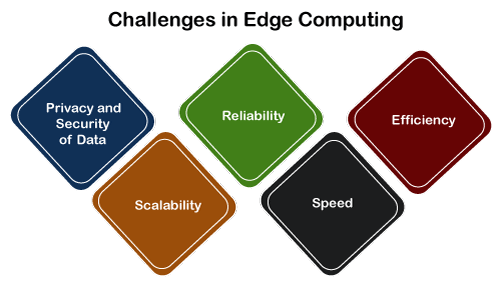
- Privacy and Security of Data: It is the new change and enhancement in technology, and so there should be change and enhancement in the privacy and security feature also. Securing part devices and the information they generate may be complex. These devices are frequently distributed to diverse locations, putting them at risk of bodily and cyber threats. Security protocols and updates want to be continuously controlled.
- Scalability: Scaling edge infrastructure to satisfy the demands of an expanding network or consumer base can be tough. It calls for cautious planning and aid allocation to make certain that processing competencies are allotted successfully. Edge Computing is based on a distributed network, and scalability becomes a challenge for such a distributed network-facing several issues. These issues are:
- Heterogeneity of Devices: A focus should be present on the heterogeneity of those devices that have its own different energy and performance constraints.
- Devices that have extensively dynamic condition and reliability of the connections in comparison to the robust infrastructure of the cloud data centers.
In addition to this, the increase in the security requirements affects and slows down the scaling factor of edge computing as it may bring more latency between the nodes that communicate with each other.
- Reliability: Such a feature is a very challenging task for every technology and so for edge computing. For handling service from certain failovers, its management is required, which is very crucial. As edge computing relies on a distributed network, so if a single node fails or unable to reach, still the users must be able to avail the service without any disturbance. Also, the edge computing must be able to alert the user about the failure node and must provide actions to recover from the failure. For this, each device should maintain the network topology of the whole distributed system that will make the detection of errors and its recovery easy to process. Other than this, the connection technology in use may provide different reliability levels and data accuracy produced at the edge that could be unreliable because of the environmental conditions.
- Speed: Edge computing should be able to provide speed services to the end-users as it brings analytical, computational resources near to the source (end users), and it leads to fast communication. Such a modern system will automatically outperform the cloud computing system, which is a traditional system. So, maintenance of good speed is also a challenging task for edge computing.
- Efficiency: The efficiency of the edge computing becomes better because the availability of the analytical tools is too close to the end-users, and due to this, AI tools and analytical tools which are sophisticated can possibly execute on the edge of the system. Such a platform improves and increases operational efficiency and thus provides several benefits to the system.
In addition to this, various factors can be discussed below:
- Latency and Bandwidth: Reduced latency is a key gain of edge computing, but it could be tough to preserve low latency as records are processed at the edge. Limited bandwidth also can be an issue, specifically in faraway or bandwidth-limited places.
- Management Complexity: Managing a massive form of edge devices, each with its very own configurations, updates, and protection necessities, may be complex. Centralized control equipment had to be simplified this way.
- Data Governance: Edge computing generates terrific portions of records, and managing and governing this information in compliance with regulatory necessities may be hard. Ensuring data privacy and safety is critical.
- Cost: Deploying and maintaining the infrastructure can be steeply priced, in particular, while coping with a massive number of gadgets inside the course of a couple of places. Organizations ought to consider the implications of problem computing carefully.
- Interoperability: Ensuring that component gadgets and structures from one-of-a-type producers and companies can work seamlessly together is a challenge. Standardization efforts are ongoing to deal with this hassle.
- Data Redundancy: Processing information at the threshold can result in truth redundancy, with a couple of tools appearing similar to operations. Managing and deduplicating statistics efficiently is critical to optimizing and processing assets.
- Remote Maintenance: Performing protection, updates, and troubleshooting for difficult devices, specifically in long, way-flung, or inaccessible places, can be logistically complicated and luxurious.
- Environmental Impact: Edge computing infrastructure consumes electricity and resources. It's important to take into account the environmental impact of deploying edge devices, particularly in far-off or ecologically touchy areas.
Addressing these challenges in edge computing requires an aggregate of progressive technologies, robust safety functions, effective management solutions, and careful making of plans to attain the blessings of localized records processing while mitigating ability drawbacks.
Why Edge Computing
Edge Computing is a new type of technology that will not only save time but also save the cost of servicing and other charges too. There are the following reasons that will answer the question:
- Through edge computing, it allows smart applications and devices for responding to data very quickly as soon as it is created and thus removing the lag time.
- Edge Computing also enables data stream acceleration that includes real-time processing of data without latency use. Data Stream acceleration is, however, critical for self-driving cars type of technologies and provides equal and vital benefits for the businesses.
- Efficient processing of data at large scale by allowing processing close to the source, and it saves the use of internet bandwidth also. Thus, it reduces the cost and enables effective accessibility to the applications in remote locations.
- The ability of edge computing to provide services and processing data at the furthest distance makes a secured layer for the sensitive data without keeping it into a public cloud.
Applications of Edge Computing
Today, the world relies on the Internet from small to big things, and thus the prices of IoT devices such as sensors and computing cost is reducing too. In this way, more things will remain connected to the Internet. As a result, more connected devices become available, and edge computing will go on demand. There are following sectors that will be potentially benefitted from Edge Computing:
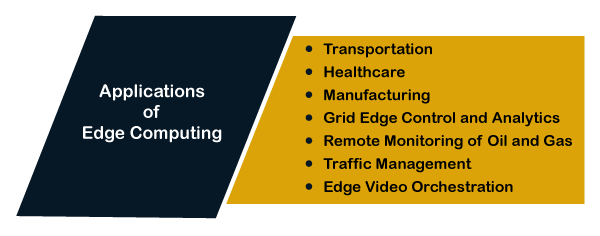
- Transportation: It is one of the most potential sectors where edge computing plays a vital role and particularly in autonomous vehicles. It is because autonomous vehicles are full of different sensors types from the camera to the radar system of the car. Such autonomous devices can essentially utilize edge computing for processing data too close to the vehicle through these sensors, and consequently, a good amount of time will be saved. But these autonomous cars are not the mainstream yet, and it is still in preparation. The Automotive Edge Computing Consortium (AECC) in the year 2018 that it would be launching the operations which are focused on the connected car solutions. But not only the self-driving cars, edge computing will be focused upon trains, aeroplanes, and other transportation forms also.
- HealthCare: People rely on fitness trackers, smartwatches, stamina measurement watches, etc., and find these health-monitoring wearable comfortable. However, the real-time analysis is essential for capturing the actual benefits of the collected data because many health wearables devices are directly connected to the cloud while others can be operated in an offline mode only. Certain health devices analyze the pulse rate and sleep pattern in an offline mode only, and doctors use to check and evaluate the patients on the spot using the analysis result. Such smart devices are useful for collecting and processing data in treating patients in any pandemic (such as COVID-19). By the use of edge computing, scientific professionals can acquire and approach facts more quickly, which may motivate higher and faster patient care, which includes a safety layer to PDHD (patient-generated fitness statistics). Through edge computing, hospitals and doctors will be able to use and access more clod applications more quickly, but the security and privacy of data is still a confusion.
- Manufacturing: Edge computing in the field of manufacturing will reduce the data that goes to the cloud for applications like predictive maintenance, and it will move the operational technology to the edge computing platforms for running process similarly as processed in the cloud but with more speed and result. However, the maintenance of an on-premise deployment is still reliable on the cloud.
- Grid Edge Control and Analytics: These smart grid controls work by creating two-way communication channels via WAN protocols between the power distribution infrastructure, consumers, and the utility head-end. However, edge grid computing is capable of providing advanced real-time monitoring and analytics and also producing actionable insights on distributed energy that generates resources like renewables. Such capability is available in edge computing technologies only. Edge Grid Computing can, however, reduce the overall cost, wastage of energy, avoid out stages and overcompensation if electric vehicles, wind farms and hydroelectric dams that generate a massive amount of useful data can assist the utilities with analytics on requirements, peak usage predictions, availability, and energy production.
- Remote monitoring of Oil and Gas: At present, IoT devices are providing modern safety monitoring, sensory devices for controlling, viewing, and sensing the temperature, pressure, moisture, humidity, sound, and radiation of oil and gas. IP cameras and other IoT devices generate massive and continuous amounts of data, and then the data is combined as well as analyzed in order to provide the key insights for evaluating the health of any running system reliably. With edge computing, real-time safety monitoring can be possible for safeguarding critical machinery infrastructure and oil and gas systems from disasters. Also, several edge IoT monitoring devices are being developed, keeping safety and reliability as the main focus points. Edge Computing allows analyzing, processing, and delivery of data to the end-users in real-time. Consequently, it will enable the control centers to access the data instantly as it occurs, preventing the malfunctions in the most optimized manner. Thus, oil and gas services are the critical infrastructures that can be catastrophic in nature if not maintained with safety and precautions.
- Traffic Management: Traffic is the worst waste of time and needs to be optimized. The best way to optimize traffic is by maintaining and improving real-time data. For the traffic management process, the smart transportation systems such as self-driving cars, and other sensory systems make extensive use of edge computing devices. Through edge computing, a massive amount of sensory and other data is analyzed, then filtered, and finally compressed before transmitting on the IoT edge gateways to other systems for use. As a result, edge computing reduces network expenses, operating processing, and storage cost for undertaking traffic management solutions.
- Edge Video Orchestration: It uses edge computing resources for delivering heavy bandwidth videos by implementing a highly optimized method. It does not deliver the video through a centralized core network to all networks. Instead, it orchestrates, caches, and distributes the video files closely to the device. Through edge computing, it is fast to serve the freshly created video clips and live streams to the paying customers via rich media processing applications that run on mobile edge servers and hotspots in venues. Thus, avoiding certain quality issues that of the mobile networks when delivering heavy videos (terabyte size) and reducing the service costs too. Still, the development of such edge computing is in the process but will boon in the coming years.
Benefits of Edge Computing
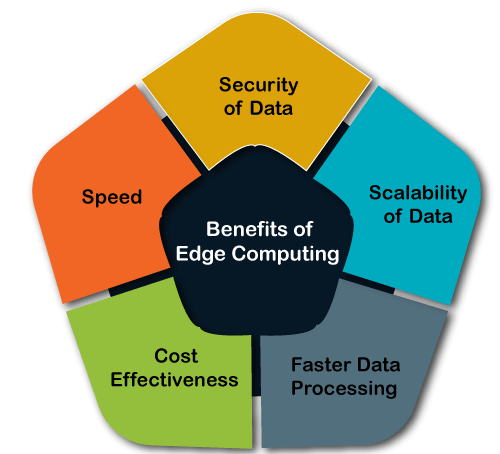
There are the following benefits of Edge Computing:
- Speed: It is the most attractive and essential factor in any field and especially in the computer science field. Every company and industry demand high-speed technology aspects such as financial organizations because slow speed data processing can make a heavy financial loss to the company, healthcare industries because a fraction of second either can save the patient's life or can take the life, and other service-providing industries need fast speed computing otherwise it can irritate the customers which will make a bad impact of the industry on its customers. Edge Computing will definitely benefit these sectors because of its extremely fast computing speed. Through edge computing, the latency of the networks will be decreased, and also IoT devices will process data at edge data centers. Thus, data need not be traveled back to the central server (i.e., centralized server).
- Security of Data: In edge computing, data is located near to the source, which will distribute the work of data processing across several data centers as well as devices. It will safeguard your data from any type of cyber attack that can be vulnerable for confidential data such as safeguarding data from DDoS attacks. Thus, the data can be saved from the hackers to harm the data as the area of attack will increase because data is not placed at a single location only, i.e., data is decentralized. Also, when data is stored locally, it will become easy to monitor the data for its security purposes and thus will enable the industries to maintain the privacy of the data.
- Scalability of Data: Scaling becomes easy and simple with edge computing where one can buy edge devices with high computation power for increasing their edge network. There is no such requirement to make their own private and centralized data centers for fulfilling their data needs. Just combine the edge computing with colocation services in order to expand your edge network. Otherwise, companies need to purchase new equipment for expanding their IT infrastructure. Thus, it will save the companies for purchasing new devices. It is enough if the industries by few IoT devices to expand the network.
- Faster Data Processing: There are varieties of IoT applications that operate together, and if they are centralized, the server will no doubt slow down the speed. Also, a massive amount of data is also generated that can create complexities for both servers and all the fragments of the IoT devices. However, if the server slows down or fails, the devices which are connected will also fail. Through, edge computing data can be accessed locally or near to the connected devices. Through, edge computing the cost of moving data, i.e., (traveling cost) to a centralized server, is also saved, and the time is taken for processing the data also becomes fast. All this brings more efficiency over the data. Also, when the entire network is not busy in exchanging data all the time, it saves a lot of network clustering and maintains data sharing between nodes only when required.
- Cost-Effectiveness: Edge Computing has gain popularity because it is the most cost-effective method as compared to the existing alternative technologies. It is because edge computing reduces the cost of data storage, network costs, data traveling costs, and data processing costs. Also, edge computing ensures interoperability among modern legacy and smart IoT devices, which are not compatible by concerting those communication protocols that are used by the legacy devices into a language that could be understood by the modern smart devices as well as the cloud. Thus, there is no need to invest money in purchasing new IoT devices because we can easily connect the existing or older IoT devices via edge computing. With this, edge computing also enables the fragments to operate without any high-speed internet connectivity as for operating cloud functionalities, high-internet connectivity is essential.
Disadvantages of Edge Computing
There are the following disadvantages of edge computing:
- Edge Computing requires more storage as data will be placed and processed at different and various locations.
- As in edge computing, data is kept on distributed locations, and security becomes a challenging task in such an environment. It often becomes risky to identify thefts and cybersecurity issues. Also, if some new IoT devices are added, it can open gates for the attackers for harming the data.
- It is known that edge computing saves many expenses in purchasing new devices, but edge computing is also expensive. It means the cost is too high.
- It needs advanced infrastructure for processing data in an advanced way.
- However, edge computing fails to pool resources in a resource pool. It means it is not capable of performing resource pooling.
- It has a limit to a smaller number of peripherals only.
Edge Computing Vs. Cloud Computing
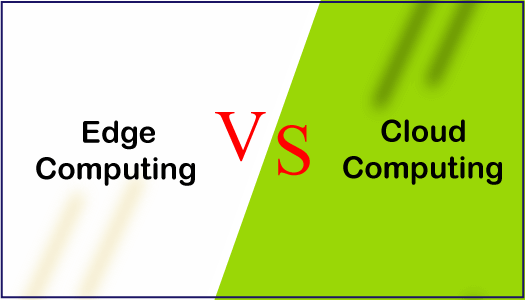
Although edge computing does not replace cloud computing technology, the emergence will certainly reduce and impact cloud computing. On the other hand, edge computing will enhance cloud computing technology by providing less complex solutions for handling messy data. Both these technologies have its own purpose and use, below we have discussed several points that distinguish between edge and cloud computing:
| Edge Computing |
Cloud Computing |
| It is good to be used for those organizations that have a limited budget to invest in financial resources. So, mid-level organizations can use edge computing. |
It is generally recommended for processing and managing a high volume of data that is complex and massive enough. Thus, such organizations that deal with huge data storage use cloud computing. |
| It can use different programming languages on different platforms, each having different runtime. |
Cloud Computing works for one target platform using one programming language only. |
| Security in edge computing needs tight and robust plans such as advanced authentication methods, network security, etc. |
It does not need high and advanced security methods. |
| It processes time-sensitive data. |
It processes that data that is not driven by time, i.e., not time-driven. |
| It processes data at remote locations and uses the Decentralization approach. |
It processes and deals with data at centralized locations by using a centralized approach. |
| Organizations can indulge in edge computing with the existing IoT devices, advance them, and use them. There is no need to purchase new devices. |
For advancement, existing IoT devices need to be exchanged with the new ones that will cost more money and time. |
| Edge Computing is the upcoming future. |
Cloud Computing is the currently existing technology. |
|





 For Videos Join Our Youtube Channel: Join Now
For Videos Join Our Youtube Channel: Join Now










